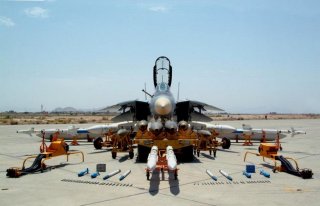Tehran's Top Guns: How Iran's Old School F-14 Tomcats Stay in the Air
Somehow, this 1970s era fighter won't go away.
The F-14 Tomcat first flew in 1970 and was intended to fly from American aircraft carriers to protect from massed Soviet bombing formations.
The not-so-secret recipe to the F-14 Tomcat’s success was its variable geometry wings, that could be optimized for low speed and high-speed maneuvers.
During low-speed flight, the F-14’s wings would be swept outwards, generating higher amounts of lift. The F-14’s relatively wide fuselage and widely-spaced engines also helped to generate some lift, important when landing on short aircraft carrier decks.
At higher speeds, the Tomcat’s wings would be swept inwards, creating a lower-drag, more aerodynamic shape. When parked, the Tomcat’s wings could be tucked in even further, allowing for more space to park other airframes onboard cramped aircraft carrier decks.
The F-14s were extremely maneuverable and easy to fly. A former F-14 pilot detailed how just how quickly Iran’s Tomcat pilots learned how to maneuver the large fighters.
“F-14s equipped with the AWG-9 pulse Doppler radar, the Iranian pilots could hit an enemy aircraft from 100 miles away, but the pilots also appreciated the airplane’s fighting abilities close in. Major Farhad recalls the airplane’s maneuverability: “The capability of the F-14A to snap around during the dogfight was unequalled… After only 100 hours of training, I learned to pitch the nose of my Tomcat up at a 75-degree [angle of attack] in just over a second, turn around, and acquire the opponent either with Sidewinders or the gun.””
The Most Successful F-14 Pilot in History
Before the Iranian Revolution, a number of F-14s were exported to Iran.
The F-14 was the platform piloted by Jalil Zandi during the 1980-1988 Iran-Iraq War. He is credited with doing 11 Iraqi aircraft, making him Iran’s Ace of Aces — and the most successful F-14 pilot ever.
Despite the F-14’s age, a number of F-14s apparently made an appearance over Syria, when they flew escort for Russian Tu-95 bombers.
Air-to-Air Killer
Despite updated livery, and supposedly “updated” air-to-air missiles (which is most likely a reverse-engineered IM-54 Phoenix missile from the F-14 fleet which has since been retired from U.S. inventories, along with the F-14 itself.
Still, the IM-54 was a very capable missile, and comparably only with the F-14s.
“Iraqi pilots seemed to have learned respect for the F-14. They faced the aircraft again during Operation Desert Storm, begun only three years after the United Nations-mandated cease fire ended the Iran-Iraq hostilities. U.S. F-14 pilots who flew the fighter on escort and photo reconnaissance missions in Iraq reported that Iraqi aircraft would break off an approach once the Tomcat’s AWG-9 radar fired up.”
Not bad for a 1970s era airframe.
Resistance Economy
The F-14 is an example of Iran’s so-called “resistance economy” wherein Iran stretches its resources to the limit, getting the most mileage out of their planes as possible by domestically-built or internationally-acquired parts We’ll likely see Iran’s F-14s until they’re shot out of the sky.
Caleb Larson is a Defense Writer with The National Interest. He holds a Master of Public Policy and covers U.S. and Russian security, European defense issues, and German politics and culture.

